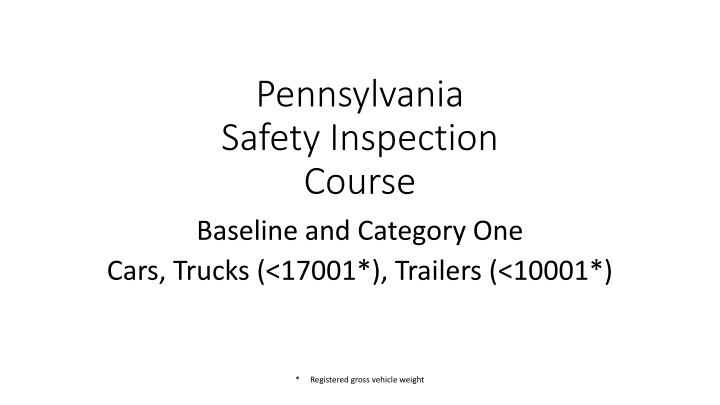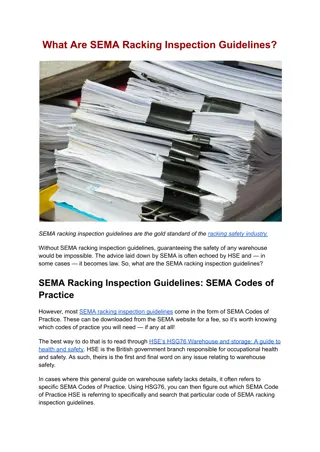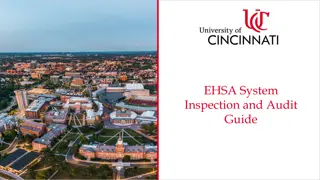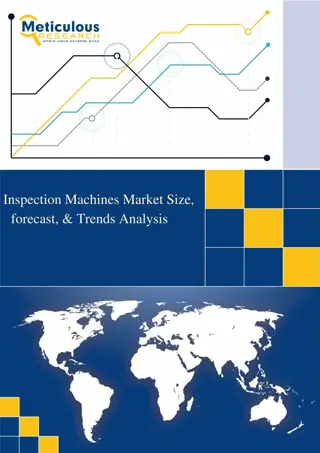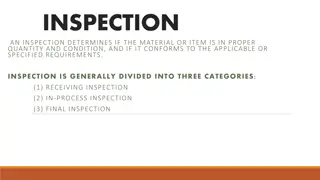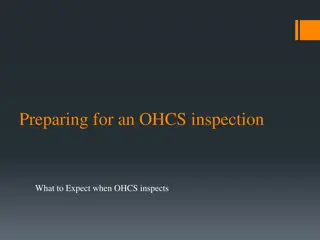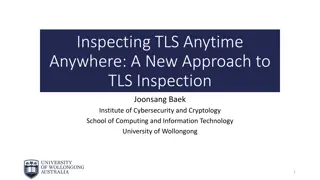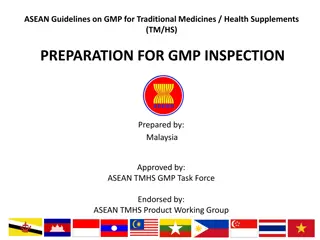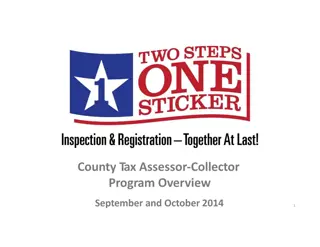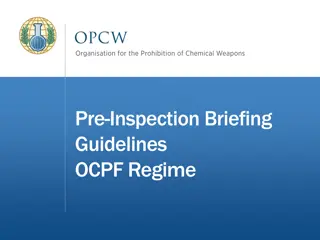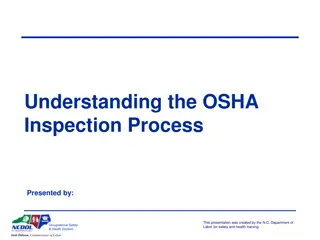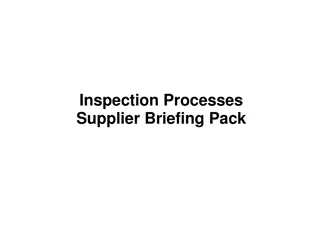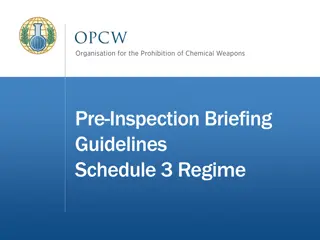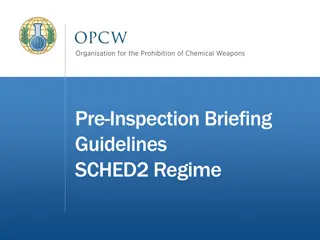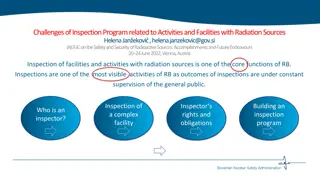Pennsylvania Safety Inspection Course Overview
This course presents essential materials derived from the Pennsylvania Motor Vehicle Code for inspecting baseline and Category One cars, trucks, and trailers. It covers windshield definitions, lighting regulations, and inspector licensing requirements to ensure proper vehicle inspections. The course emphasizes the need-to-know information for inspecting technicians to perform thorough inspections. Inspector licensing is categorized into Baseline and Categories I-IV, with mandatory tests and age requirements. Understanding the course materials is crucial for obtaining and maintaining the necessary inspector license.
Download Presentation

Please find below an Image/Link to download the presentation.
The content on the website is provided AS IS for your information and personal use only. It may not be sold, licensed, or shared on other websites without obtaining consent from the author.If you encounter any issues during the download, it is possible that the publisher has removed the file from their server.
You are allowed to download the files provided on this website for personal or commercial use, subject to the condition that they are used lawfully. All files are the property of their respective owners.
The content on the website is provided AS IS for your information and personal use only. It may not be sold, licensed, or shared on other websites without obtaining consent from the author.
E N D
Presentation Transcript
Pennsylvania Safety Inspection Course Baseline and Category One Cars, Trucks (<17001*), Trailers (<10001*) * Registered gross vehicle weight
Overview and Description of Course This course is derived from sections of the Motor Vehicle Code (75 Pa. C.S. 4101-4982). It is presented in a format that is more readily understandable than the Code itself. It does not have every word of the Code in the Course, rather it calls out the need-to-know material that an Inspecting Technician must have to perform an inspection properly. If questions arise outside of the Course material, we will refer to the Code. PennDoT has separated the Inspector Licensing into Categories while the Code is separated into Subchapters. We will make the distinctions clearer in a moment. An Inspector must take the Baseline Category once in his/her career. The other Categories, I through IV, can be taken at any time during their career development. The Inspector must be 18 years of age and have a current Drivers License for any Category that they intend to inspect. Additionally, the Inspector must take and pass a written and hands-on test (70% grade) in each Category Section that applies to those vehicles requirements. If you ever have a question, do not guess. Check this document or the Code. Your license depends on it
Definitions The windshield has four sections as defined by PennDoT. The ACUTE section is an 8 w X 5 h rectangle directly in front of the driver s vision area. A tall driver may have a different vision area than a short driver. There cannot be ANY defects in this area. The CRITICAL section is the area contacted by the wiper blades. There cannot be ANY discolorations or hazardous cracks that interfere with the driver s vision. The AS1 section does not exist in all windshields. If there is an AS1 etching on the windshield at the left side A pillar, a few inches down from the roof line, then any section of the windshield above that etching is not considered windshield. As a result, decals and tint and other material can be placed on the glass. (See illustration.) Passenger cars may not have anything on the windshield or windows to the side of the vehicle operator other than factory tinted glass. They may have decals, signs, etc. that do not cover more than 20% or extend above 3 inches from the bottom on the windows behind the vehicle operator. Multipurpose vehicles, SUVs, trucks, and vans may have non-OEM product on the glass, from the left side B pillar around the rear of the vehicle and up to the right side B pillar. They are required to have two side view mirrors, one on each side of the vehicle, with a minimum reflective surface of 19.5 inches.
Definitions (continued) Lighting is a large part of the Equipment Regulations. AUXILIARY DRIVING LIGHTS are used to supplement the HIGH BEAMS on a vehicle. They must be equally spaced from the centerline of the vehicle, 20 inches apart, and no more than 42 inches above the ground. They must have a pilot lighted switch indicating when they are on or they must be wired to go off when the HIGH BEAMS go off. The bulbs must project white light only and cannot be substituted for other lights. They are aimed straight out from the vehicle, as mounted. FOG LIGHTS are used to supplement the LOW BEAMS on a vehicle. Their mounting and aiming requirements are the same as AUXILIARY DRIVING LIGHTS. They must have a pilot lighted switch indicating when they are on or they must be wired to go off when the LOW BEAMS go off. The vehicle must have 2 LOW BEAM HEADLIGHTS and 2 HIGH BEAM HEADLIGHTS. The configuration is OEM defined, in that they may be incorporated into individual bulbs, individual fixtures, or an integrated fixture. The LOW BEAMS are adjusted to project the main part of the beam 4 inches down from horizontal and 4 inches to the right at a distance of 25 feet. The HIGH BEAMS are adjusted straight out from the vehicle. The LOW BEAMS must have a minimum candlepower* of 7500 and the HIGH BEAMS must have a minimum candlepower* of 10,000. (See illustration and explanation about candlepower*)
Definitions (continued) The vehicle must have additional lighting as follows: Indicator lights (dash warning lights) visible to operator of vehicle that lamps are on, malfunctions exist, or action is required. Parking lights low intensity lamps, front and rear projecting, usually on with HIGH BEAMS and/or LOW BEAMS, but able to be operated separately. Side marker lights low intensity lamps, sideways projecting, front and rear, to indicate length of vehicle. License plate light low intensity lamp(s) to illuminate license plate. Visible at 50 feet. Tail lights Red lamps on rear of vehicle that are illuminated whenever headlights, fog lights, or auxiliary driving lights are on. Visible from 500 feet at night and 100 feet in daylight. Stop lights, including HMSL, turn signals, hazard warning lights specific function lamps that indicate stopping, turning, and 4-way flasher warnings. Turn signals may be integrated into stop light circuitry. All lights must be visible at 100 feet in daylight and 500 feet at night. Turn signals must flash at 60-120 times a minute. Fog lights are not a required lamp but must work if present. Ornamental lamps non OEM equipped lighting. Only considered lighting if operating. All are illegal.
Definitions (continued) Reverse lights low intensity lamps that are automatically illuminated when vehicle transmission is placed in reverse. They must go out when vehicle transmission is shifted out of reverse. A manual pilot lighted switch for on-off operation is acceptable but vehicle may not be forward driven with reverse lamps on. Snow plow lights substitute lighting used when snow plow is installed. Lighting requirements are the same as low beams and high beams. The operation of these lights is accomplished with a double pole switch that only allows one set of lights to be on at a time. Reflex reflectors must be in all lenses as equipped from OEM and cannot be blacked-out . CAUTIONS Headlight fogging required headlight output cannot be achieved through lenses on headlights that are not clear. Roll bar lights was previously considered to be lighting on pickup truck roll bars. Now, it is considered aftermarket LED lighting in grills, visors , on roof, etc. This lighting must have lighted pilot switch to indicate when the lamp is on and lighting must be covered when vehicle is on the road.
Definitions (cont.) PennDoT defines all types of vehicles that operate on Commonwealth roadways. Antique vehicle 25 years old or older and registered as such Classic vehicle 15 years old or older and registered as such (original) Collectible motor vehicle substantially modified show quality vehicle Reconstructed vehicle a vehicle that has damage in excess of its value, as determined by an insurance company, and has been retained by the original owner in exchange for the salvage value, as determined by the insurance company. The title is relinquished to PennDoT and a Certificate of Salvage is issued. Specially constructed a non-OEM vehicle. Street rod a 1948 or older vehicle, original or reproduction, largely altered or modified in its essential parts. GVW may not exceed 9000 pounds.
Definitions (cont.) Light truck registered gross weight of 11,000 pounds or less Medium truck registered gross weight of 11,001 to 17,000 pounds Heavy Truck registered gross weight of 17,001 or more pounds including truck- tractors. Motor carrier vehicle gross weight or registered gross weight of 17,001 pounds or more including a truck, truck-tractor, or combination. Motorcycle - a two or three wheeled vehicle with a seat for an operator. It may have two additional wheels ( training wheels ) on the rear. Motor driven cycle a motorcycle or scooter with less than 5 brake horsepower. Moped a pedal operated cycle with gas or electric auxiliary power, having less than 1.5 brake horsepower and automatic transmission, capable of no more than 25 MPH
Definitions ( cont.) Additionally, there are different types of Inspection Stations appointed by PennDoT General Inspection Station - the most common type of Station. It is open to the general public at least 40 hours a week between the hours of 7:00 am and 8:00 pm Monday through Friday. A waiver may be obtained from PennDoT to alter these times but the Station must be open at least a total of 10 hours between 7:00 am and 8:00 pm Monday through Friday. Fleet Inspection Station open only for fleet operations consisting of more than 15 vehicles. Personally owned/registered vehicles cannot be inspected. Vehicles leased in the company name may be inspected. Commonwealth Inspection Station open only for vehicles that are owned/leased by a government agency i.e. a township, borough, county, state, or Federal Government. Motorcycle Inspection Station a general station appointed to inspect motorcycles.
Definitions (cont.) Trailer Inspection Stations open to the public, fleet, or Commonwealth to inspect trailers. Enhanced Inspection Station open to the public for the first-time inspection of reconstructed, modified, street rods, specially constructed, collectible, theft or flood recovered vehicles in order for the vehicles to be titled in Pennsylvania. It should be noted that a Station may be appointed as multiple types. Parking brake mechanical/electrical brake system that holds the vehicle from moving when parked in neutral. It must hold the vehicle from moving when parked on a 20% grade. It also must stop the vehicle, while operating at 20 MPH, in 54 feet. Service brake used for stopping vehicle under normal operating conditions. In the case of a passenger car it must stop the vehicle, while operating at 20 MPH, in 20 feet. Brake pedal pad cannot be worn through or missing. QAO Quality Assurance Officer, responsible for auditing Inspection activities. The Pennsylvania State Police are responsible for investigating wrongdoing or illegal activities.
T DOT and Semi-Annual Inspection Temporary Inspection Approval Indicator T-DOT or TEMP sticker. It is installed on the back of an existing Safety sticker (upper left corner) to indicate a vehicle has passed the Safety Inspection but has not passed the Emission test. More on this subject comes later. All vehicles are subject to annual Safety Inspection except school buses, mass transit buses, school vans and vans used to transport people for hire or employment. These exceptions are subject to a semi-annual Inspection. Vehicle owners who have been out of state for 30 days or more and do not have a current Inspection sticker on the windshield have 10 days to get the vehicle inspected. The same rule applies to newly purchased vehicles. An out of state registered and insured vehicle may receive a Pa. Safety Inspection with or without a Sticker issuance.
Station Requirements PennDot appoints/authorizes a Station to perform Inspections based upon an application called an MV 427. In essence, the Inspector is an agent for the Commonwealth, working in a facility that is approved by PennDoT for the specific types of vehicles noted on the MV 427. The appointment/authorization is specific to the individual/Corporate representative that signed it, at the described location. It is non-assignable and can be cancelled or suspended by PennDoT for cause. An information packet is available from PennDoT with all of the specific requirements for making application. Upon approval by PennDoT, the QAO will visit the location, affirm the information, and deliver the MV 427, which becomes the Certificate of Appointment. This Certificate must be posted in a conspicuous place, viewable by the public. Some of the required materials include a $10,000 liability insurance policy or bond with PennDoT, Vehicle Inspection Division, PO Box 68696, Harrisburg, Pa 17106-9003 named as Certificate Holder. This means that PennDoT will be notified automatically by the insurance company if the policy/bond lapses or is cancelled.
Station Requirements (cont.) The applicant must be a natural person or a Corporation. In the case of a Corporation, the applicant must have written authorization, on Corporate letterhead, authorizing the individual to act on behalf of the Corporation in this matter. The applicant must be able to read and understand the Vehicle Code. In addition to the MV 427, an MV 443 must be posted in a conspicuous place, usually near the MV 427. This allows the public to know the credentials of the inspector. Any additions or deletions on the MV 443 should be noted on the document and then faxed to the QAO office at 215.793.1061. Two additional signs are required in a General Inspection Station. A sign stating the specific fees associated with the inspection i.e. sticker fee, labor for the inspection, shop fees, taxes. Each Category that the Station inspects must be itemized. The only exception is the fee for the Document Reviewer, part of the Category IV Enhanced Safety Inspection. Also the sign must state that the fees are Pass or Fail indicating to the public that the fees are for the labor of inspection not the sticker .
Station Requirements (cont.) The inspection area size requirements vary according to vehicle and headlight checking equipment. The required area must be space in the clear and may only have a lift within the dimensions. Category I station (autos and trucks up to 17,000 pounds registered GVW) 12 by 22 or 12 by 43 if a headlight screen is used. Category II station (motorcycles) 10 by 18 or 10 by 32 if a headlight screen is used. Category III (trucks over 17,000 pounds registered GVW) 12 by 64 . A trailer station must be 12 by 53 which is included in the truck station requirements. A truck-tractor may be inspected with trailer or without. The entire inspection must be conducted within the required area. The tools required in the Station are those that are generally required to service and repair the vehicles that are approved on the MV 427 with some specific additions:
Station Requirements (cont.) Tire pressure gauge Micrometers to measure rotors and drums Ball joint gauge* Tire tread depth gauge* Brake thickness gauge* Headlight aiming device (may be a screen) Hole punch (1/4 or 3/8 ) for voiding stickers The headlight aiming device must accommodate all inspected vehicles
Station Requirements (cont.) An inspection station is almost always part of a vehicle service and repair business. As a result, the station must be open 40 hours a week between the hours of 7 am and 5 pm Monday through Friday. A waiver for special exceptions may be obtained from PennDoT but regardless, the station must be open at least 10 hours between 7 am and 8 pm Monday through Friday. This waiver may be rescinded for noncompliance. An inspector must be 18 years of age, pass a certification course, pass a hands-on test, and have a current drivers license for each Category he/she inspects, though a school bus drivers license is not required. The inspector may inspect 3 motorcycles an hour or 2 of any other vehicle in an hour. Currently, the initial certification is good for 3 years. The online recertification, required after the 3 years, is good for 5 years thereafter.
Station Requirements (cont.) The inspector license codes start easily enough: Code 1 the most popular vehicles = cars and trucks up to 17,000 registered GVW Code 2 two wheels = motorcycles Code 3 everything else = 17,001 registered GVW and heavier trucks. Then it gets more difficult with modern math, PennDoT style: Code 4 1 + 2 + 3 = 4 = all vehicles Code 5 1 + 2 = 5 Code 6 2 + 3 = 6 Code 7 1 + 3 = 7 Code J Enhanced Safety Inspection Certified Document Reviewer administrative part of Code J is not an inspector
Station Requirements (cont.) All Station and inspector interaction with PennDoT is on a personal basis. There is no Corporate veil to exclude the individual from culpability or responsibility. It is the responsibility of each individual to conduct business in the best interest of the Commonwealth. Station owners/managers must make all bulletins and regulations available to employees. The owner/manager must notify QAO of any changes in operations whatsoever, i.e. changes in personnel (MV 443), anticipated changes in building or inspection area, or missing stickers. The owner/manager assumes full personal responsibility for all stickers and all inspections, regardless of first-hand knowledge. In the event of change of ownership - all inspection operations stop immediately. The MV 427 and unused stickers are relinquished to the QAO. In the event of partnership, incorporation, or transfer of controlling interest All inspection operations stop but materials are retained. A new MV 427 is required. In event of change of location all inspection operations stop, a new complete MV 427 application is submitted, and the QAO audits sticker usage.
Station Requirements (cont.) In the event of closing the QAO will audit records, retrieve unused stickers, retrieve MV 427, and close out station. Unused stickers costs are reimbursed at 75% In the event of death all inspection operations stop. A new MV427 must be submitted by survivor(s). Inspection operations may continue but the QAO must be notified if: Stickers are lost. Signer of MV 500 (sticker requisition from) leaves station. Change of Post Office address designation (911) Change of Company name Change of Corporate responsibility (MV 427 signer/authorization). IMPORTANT The customer must authorize all repairs. All parts must be retained until the customer picks up the vehicle. Brake and tire readings must be recorded on invoice. Any potential problems must be noted on invoice. The customer may do their own work.
Station Requirements (cont.) The General Station requirements are the most comprehensive as far as tools and equipment are concerned. There are additions to those requirements for particular Stations: Commonwealth only Federal, State, Township, Borough, or Municipal vehicles can be inspected. No charge for Stickers. Fleet minimum 15 fleet owned/leased vehicles. Can include fleet owner(s) vehicles only if vehicle is owned/leased by fleet. Inspection area must accommodate largest vehicle in fleet, trailers included. Recreational/Utility Trailer additional tool requirement of low-current ammeter (DMM). Inspection recorded on MV 480 not MV 431. External Sticker has only VIN recorded on the face of it. Motorcycle additional tool requirement of spoke wrench and truing stand. Headlight aiming device is re-emphasized. Sticker is recorded on same MV 480 as trailers. Inspection area slightly smaller (see previous specs). Enhanced additional tool requirement of light transmittance meter and candlepower meter*. Vehicle must conform to OEM specs, in addition to PennDoT Inspection Regulations.
Certificate of Inspection Let s clear this up right now only PennDoT calls a TS-460 and a TS-463 by the name Certificate of Inspection. These are stickers , the TS-460 for cars and trucks, the TS- 463 for Trailers and motorcycles. From now on we will refer to car stickers and trailer/motorcycle stickers only. The sticker must be filled out clearly in permanent ink. We can save you the trouble of experimenting, a Sharpie Fine point is the only answer; not a ball point pen, not a #2 pencil, not a Sharpie extra fine. It is worth reiterating that the only information that can go on a trailer/motorcycle sticker is the VIN because it is an external sticker; the car/truck sticker is an internal sticker. As strange as this may sound, the sticker must be installed on the vehicle within 100 feet of the station, on the same side of the street, by the Inspector who did the complete inspection. Don t ask. The old sticker must be removed completely, the surface cleaned completely, and the sticker installed neatly and squeegeed in place.
Certificate of Inspection (cont.) The sticker on a car or truck goes on the left side of the windshield as close to the A pillar as neatly possible. The sticker on a trailer goes on the left side front at about eye level, if possible; on the front frame, if not. It is not to be installed on the nose , the front panel of a trailer. Cars and trucks are inspected annually and receive a sticker based upon the following: If the month the inspection is being done, and the registration agree, then the sticker insert is issued for that month. If the vehicle is required to be Emission inspected, then an IM insert must be used and the Safety sticker may not be issued unless the new Emission Sticker has been installed. If the month the inspection is being done, and the registration disagree by 2 months early or fewer, then the sticker is issued for the registration month. If the month the inspection is being done, and the registration disagree by more than 2 months, then the sticker is issued for the month the vehicle is inspected. No sticker can be issued for more than 15 months
Certificate of Inspection (cont.) Motorcycle stickers are different, in appearance and expiration. The stickers are issued according to a PennDot published schedule, basically: May and November registration May sticker June and December registration June sticker July and January registration July sticker August and February registration August sticker September and March registration September sticker October and April registration October sticker A plain monthly expiration insert is used on all motorcycle and trailer stickers. The sticker is installed on the left side of the motorcycle, on a welded or riveted plate, on the left front fork, or on the fender. Consult with the motorcycle owner on his/her preference.
Certificate of Inspection (cont.) Record keeping is one method PennDoT has for assuring the proper conduct of inspectors and Stations. Remembering that the individual is personally responsible for the Inspection is important. One inspector is responsible for conducting the entire inspection of a vehicle. A medical exemption to this rule allows a second inspector to do the road test. Both inspectors must sign the appropriate documents, i.e. report, sticker, and repair order. Occasionally, a Station may prefer to have an assistant complete the MV 431 or MV 480. In this case, the inspector must fill out the repair order completely i.e. old mileage, new mileage, brake measurements, tire measurements, upcoming repairs that currently pass, and signature. The assistant transfers the information onto the MV 431 or MV 480 and records the inspectors number. Additionally, the assistant must sign the left margin of the MV 431 or MV 480. All records regarding the inspection process shall be retained until audited, except for the receipt issued with the stickers ordered, which shall be retained for 2 years.
Certificate of Inspection (cont.) We addressed the method of replacing the sticker in the case of a passed inspection. There are, however, two circumstances in which the process is not the same. T-Dot, Temporary Inspection Approval Indicator, Philly sticker Real and central/western Commonwealth name for a TEMP sticker. It is issued to indicate the vehicle has passed all of the Safety Inspection requirements except for the passing of the Emission Inspection and the applying of the sticker. The TEMP sticker is applied to the old sticker, still on the windshield, in the upper left hand corner of the sticker. The T-Dot was a concession by PennDoT to keep shops who did not purchase Emission equipment involved in the Safety inspection program. It serves as a notice to Emission stations that the vehicle has passed the Safety inspection and is only seeking an Emission test. Only the station who installed the TEMP sticker can install the Safety sticker upon a passed Emission test. The TEMP does not extend the Safety inspection expiration. Additionally, the vehicle must be in the condition it was in when it passed the Safety inspection. We are still searching for someone who has seen it in use.
Certificate of Inspection (cont.) Windshield replacement in the event that a windshield must be replaced, the glass technician should save the old sticker(s) and return them to the customer. The customer has 5 days in which to get the stickers replaced. The Station completes the back of the sticker with exactly the same information i.e. VIN, mileage, expiration date, and date of inspection as the original sticker. The wheels pulled boxes are left blank because it is not necessary to re-inspect the vehicle, provided it is in obviously Safety compliant condition. The information on the MV 431 or MV 480, including current insurance documentation, is completed as if the vehicle was inspected. Brake and tire measurements should have replacement sticker issued recorded. The sticker(s) should have replacement written on the back. The broken piece of windshield is saved for audit purposes. If the vehicle is currently in its 90 day inspection cycle a replacement sticker may not be issued, the vehicle must be inspected. Maximum fee for the replacement sticker is $2.00 plus sticker cost.
Certificate of Inspection (cont.) Sticker security is of paramount importance to PennDoT and should be to the Station as well. In not so many words, PennDoT encourages redundancy in securing stickers. The stickers should be in a locked safe or file cabinet which is located in a locked office or closet. Losses of stickers should be reported to the QAO immediately. The QAO will instruct the Station to file a report with the local law enforcement. The report should be saved until the next audit. As mentioned above, stickers may only be ordered by the Station employees who signed the MV 500. All forms necessary to operate an Inspection station are available on-line at www.dmv.state.pa.us except for the MV 500, available from the QAO. Violations of the use of stickers can be summed up in two ways: If you make a mistake or do something stupid you can be warned or suspended for two months. Repeated mistakes warrant longer suspensions. If you do something illegal (furnish, sell, lend, give) you will be suspended for one year the first time and permanently the second time. PennDot means business.
Inspection The Inspection procedure is a combination of common sense and technical skill delivered in a logical fashion. There are many points that are necessary to cover so it only makes sense for you to do them in an order that makes sense to you. As long as everything is covered, the order makes no difference. Let s get started. You receive a repair order with a request for services. The registration card and insurance card may be with the RO or not. The first thing to do is secure the cards, verify they are current, and verify that the information pertains to the vehicle i.e. VIN, registration plate, and expiration. Then, do a walk-around, looking for holes in body, damaged bumpers, broken or missing glass, broken or missing lights or lenses, fogged headlights, torn windshield wipers, any defect in the ACUTE area of the windshield, any cracks or discolorations in the CRITICAL area of the windshield. Start the vehicle, apply the parking brake, and see if the vehicle moves forward with very light accelerator pedal pressure. If it does move, the parking brake fails inspection
Inspection Release the parking brake. At this point, you have two choices: road test the vehicle or pull the vehicle in to the Station. Either way, the vehicle has to end up in the shop and receive an Emission Inspection test, if applicable. After that, the lights, wipers, washers, and horn should be checked. You may need an associate to verify operation of rear lights. The headlights are properly checked at each inspection with a headlight aiming device, not the fourth drawer up on your tool box. The following list specifies the distances at which items should be checked: Horn 200 feet Rear lights 100 feet (daylight) 500 feet (night) License light 50 feet Headlights (low) 7500 (high) 10,000 candlepower* Needless to say, you are not going to go 500 feet away at night to verify rear lights but you get the point.
Inspection (cont.) At this time, it makes sense to open the hood and check the brake fluid level, battery hold-down, primary and secondary hood latch/release, and bulkhead for holes. As stated previously, the order of inspection items is at your personal discretion. Some steering and suspension components need to be checked with the vehicle on the ground. It is your responsibility to determine the proper measuring procedure. Vehicles with a loaded lower arm should be jacked up under the lower control arm, unloading the ball joints. The free-play is then measured against manufacturer s specifications. MacPherson strut suspensions can be checked with wheels elevated. At this time, the vehicle should be raised to a comfortable height for checking underneath. Steering free-play, side to side at the 9 o clock and 3 o clock position, fails according to PennDoT if the play exceeds of an inch. They do not specify on a component by component basis, but, generally, movement in any steering component fails. Check the manufacturer s specifications. Check under the vehicle for exhaust mounting, exhaust leaks, exhaust system exiting completely from under the vehicle, steering and suspension components i.e. bushings, stabilizer links, shock absorber severe leakage, springs, brake and fuel lines, and tire tread depth measurements.
Inspection (cont.) The vehicle must have at least 2/32nds of an inch tread on all tires. Taxis and vehicles over 10,000 pounds GVW must have a minimum of 4/32nds of an inch tread on the front tires. There cannot be any defects i.e. bumps, bulges, cracks, excessive dry-rot, excessive curb rash , or markings indicating the tire was run flat (sidewall damage). The tires cannot have two side-by-side treads below 2/32nds of an inch. They cannot have 2 successive tie bars showing (flat spotted ???!!). The tire specifications are posted on the left side door jamb and in the owners manual. The tires must comply with all of these specifications i.e. number of tires, size, speed rating, and weight rating. You are required to remove 2 tires/wheels, diagonally opposed, to measure the brake linings, drums, and rotors. Drums and rotors that look ok need to be measured with a micrometer. The manufacturers specifications, either on the drum or rotor, or in a information system are in .001 of an inch. Your eyesight is not that good. A .015 groove in a rotor or drum is acceptable. You are responsible for verifying the parking brake operation (holding on a 20% slope) though, currently, you are not required to measure rear parking brake shoes.
Inspection (cont.) Brake hydraulics are very important. PennDoT bulletins place you at risk of passing a vehicle with potentially fatal defects. You must use your utmost discretion as a professional technician when inspecting brake hydraulics. Brake lines are a double wall tube. If you can flake the outer tubing off with you fingernail, the brake line should fail Inspection. If it has a light patina , a very light coating of rust that you almost cannot feel, it is probably ok. PennDoT states that wheel cylinders only fail if they are leaking, not seeping. You and your insurance company can decide the definitions. ABS components do not fail Inspection unless they are an integral part of the service brake system. Many OEMs use ABS pumps to enable their power brake systems. Again, it is your responsibility to understand the vehicle you are servicing and its systems. Brake friction components, pads and shoes, have a minimum thickness of 2/32nds on bonded linings and 1/32nd above the rivet on riveted linings. Friction surfaces cannot be damaged, cracked, or contaminated. Rust on rotors is another controversial subject. If rotor faces were supposed to be rusty, the OEMs would not spend time and money on rotor finishes. Enough said.*
Inspection (cont.) During the course of an Inspection, an Inspector must be aware of any conditions that may affect the safe operation of a vehicle for a year. Any frame damage, body damage, or rust holes that are not properly repaired or would allow exhaust gases to enter the vehicle would fail Inspection. Any improper operating conditions determined during the road test would cause the vehicle to fail. Any conditions that are currently passable but will be non-passable before the next Inspection must be noted on the customer Invoice along with the brake and tire measurements. Category I permits the Inspector to Inspect trailers from 3001 pounds GVW to 10,000 pounds GVW in a trailer Inspection approved Station. Inspection regulations are almost identical to cars and light trucks pertaining to lights, brakes, frame, and body. One addition is a break-away device. Electrical or surge, it automatically is triggered by a cable attached to the towing vehicle in the event of a trailer uncoupling. The battery and switch must operate properly and the surge brake device must operate properly. The other addition is perhaps more side lighting and conspicuity (red/white) tape. Follow the chart in your information packet.
